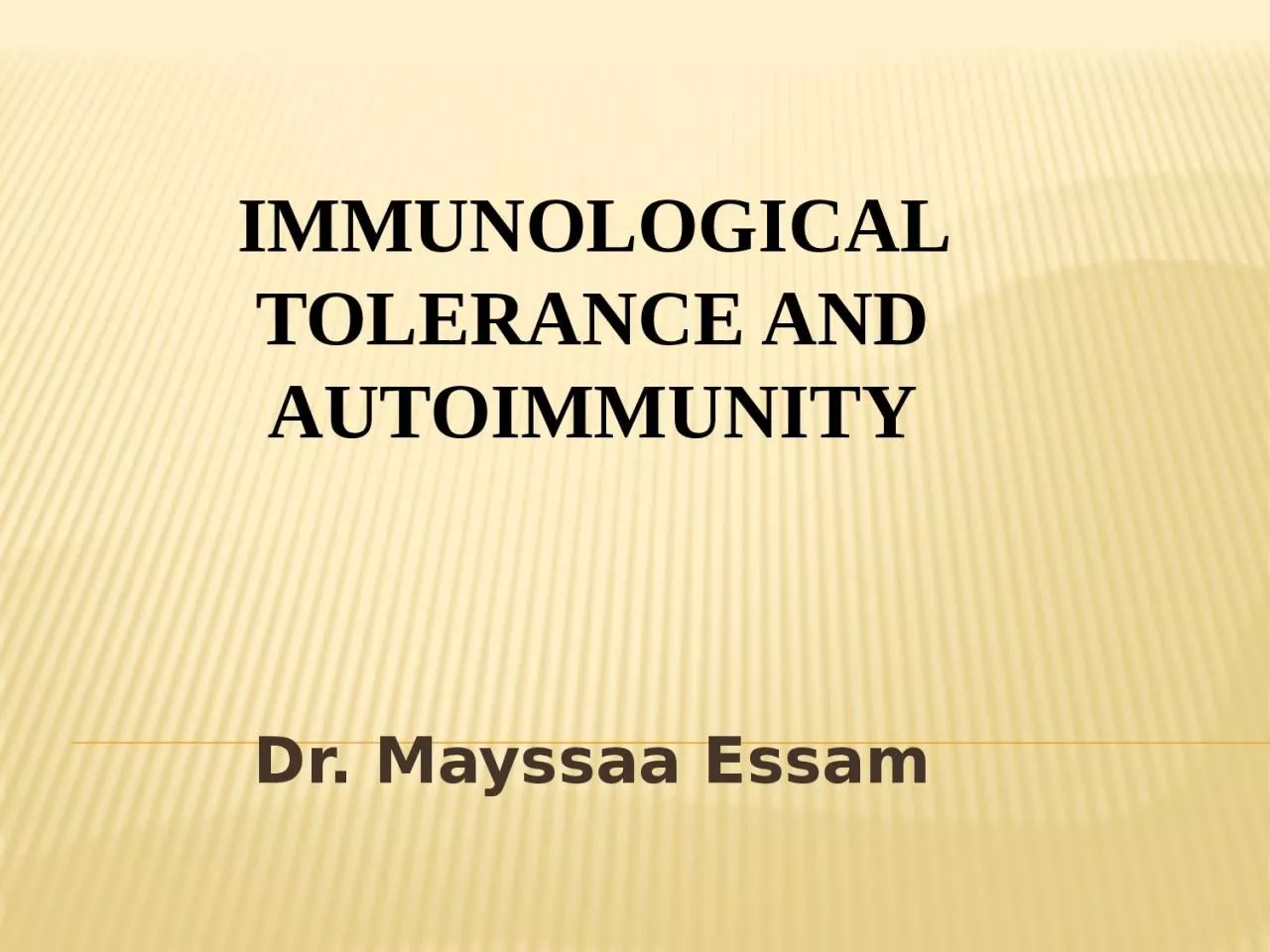

immunological tolerance Immunological tolerance is a state of unresponsiveness to a particular antigen to which a person has been exposed earlier The important aspect of tolerance is the selftolerance which prevents the body to mount immune response against selfantigens ID: 919220
Download Presentation The PPT/PDF document "Dr . Mayssaa Essam IMMUNOLOGICAL TOLE..." is the property of its rightful owner. Permission is granted to download and print the materials on this web site for personal, non-commercial use only, and to display it on your personal computer provided you do not modify the materials and that you retain all copyright notices contained in the materials. By downloading content from our website, you accept the terms of this agreement.
Slide1
Dr. Mayssaa Essam
IMMUNOLOGICAL TOLERANCE AND AUTOIMMUNITY
Slide2immunological tolerance Immunological tolerance is a state of unresponsiveness to a particular antigen to which a person has been exposed earlier.
The important aspect of tolerance is the self-tolerance, which prevents the body to mount immune response against self-antigens
.
the
immune cells (lymphocytes) possess vast diversities of antigen receptors, it is possible that some receptors may be self-reactive.
Slide3Immunological tolerance classified into central tolerance or peripheral tolerance depending on where the state is originally induced—in the thymus and bone marrow (central) or in other tissues and lymph nodes (peripheral). Central
tolerance
is the main way the immune system learns to discriminate self from non-self.
Peripheral
tolerance
is key to preventing over-reactivity of the immune system to various environmental entities (allergens, gut microbes,
etc
).
Slide4The first evidence of self-tolerance was introduced by Traub in 1938, who inoculated mice, in utero, with lymphocytic choriomeningitis virus producing infection and maintained it throughout life. These inoculated mice, unlike normal mice did not produce neutralizing antibodies against the virus
.
Tolerance
could be induced, if some foreign antigens are administered during
embryonic life
and also in
neonates
.
Slide5The key factor determining the tolerance is not the developmental stage, but the state of maturity of the immune cells (lymphocytes) at the time of the encounter of the antigen. In unborn and neonates, the immune cells are still to mature and therefore, the individual remains unresponsive at this stage.
Slide6Central tolerance is established by deletion of lymphocytes in primary
lymphoid organs
(thymus for T cells and bone marrow for B cells) if they possess receptors that can react with self antigens or by the emergence of regulatory
T cells that can inhibit self-reactive cells.
Slide7Slide8peripheral tolerance mechanisms - Colonal ignorance.
The
self-reactive lymphocyte is present in the periphery, but does not „see“ the antigen it is directed
against Immune-privileged
sites
:-
•
brain • eyes • testes •
placenta,
and fetus
Control
of T-cell trafficking to
tissues.
Naive
cells recirculate through secondary lymphatic organs and bloodstream, but do not enter into tissues under normal
conditions.
Slide9- Clonal anergy Full activation of T cells requires costimulation
through CD28 in addition to TCR
ligation.
TCR ligation in the absence of
costimulation
leads to inability to express effector functions like cytokine secretion, and makes the cell unresponsive to further
stimulation.
Control
of the expression of the costimulatory molecules CD80 and CD86 (B7) is a major mechanism of peripheral tolerance
.
- T cell suppression
.
Slide10AUTOIMMUNITY The term autoimmunity refers to a failure of the body’s immune system to recognize its own cells and tissues as “self”,
Instead
immune responses are launched against these cells and tissues as if they were foreign or invading bodies
.
It occurs when
mechanism of self-tolerance fail.
Slide11Mechanisms of autoimmunity*Ag released from hidden location
.
*
Antigen
generated by
molecular changes
.
*
Molecular
mimicry.
*
Alteration
in
Ag processing
.
*Infection
.
*Genetic
factors.
Slide12Mechanisms of autoimmunity*Lymphocytes abnormalities.*Failure of central tolerance.
*
Overcome
of peripheral tolerance.
*Polyclonal
lymphocytes activation.
Slide13Ag related from hidden location Many self Ag are found in hidden location eg. TESTES ,EYE (CORNEA)
organ
damage
1.
Hidden Ag
released
2
. Reaches blood
stream
3
. Encounter Ag sensitive cells
4. Stimulate autoimmunity
Slide14Antigen generated by molecular changes Development of completely new epitopes on normal protein.
1.
Ab + Ag
.
2. New
epitopes exposed on Fc region of
Ab.
3.Stimulate
the formation of
Rf
.
4.
Establishment of disease like
rheumatiod
artheritis
.
Slide15Molecular mimicry1.Sharing of epitopes between an infectious agent and its host.2.Antibodies
directed against the
infectious.
3.Agents
starts reacting with normal self Ag.
4.Triggers
autoimmunity.
Slide16Alteration in Ag processing1.T cell may fail to develop tolerance to an self
Ag
simply because
it is not efficiently procured.
2. Something
happens to improve the
processing
, an autoimmune disease may be triggered.
3.This
usually
happens at the site of
inflamation
resulting
in modified Ab.
eg
.
Thyrotoxicosis ,
Diabetese
.
Slide17Infection Autoimmunity is not due to infectious agent itself ,but results from dis- regulation of host immune response by the microbes.
This
may be due to
:
*Polyclonal
lymphocyte activation
.
*
E
nhanced
stimulation of co stimulator
.
*Alteration
of self Ag(cross reactive
neo-Ag).
Example:
papilloma virus (HPV) and insulin
receptor.
Slide18GENETIC FACTORS The important genes that regulate the development of autoimmunity are located within MHC.*MHC
have got critical role in
maturation of T cell
.
*
MHC
ll
genes are directly
responsible for auto
antigen processing
and
presentation
.
*The
structure of Ag binding groove will determine , if specific Ag will trigger an AU response.
Slide19Slide20Lymphocytes abnormalities* Primary abnormalities either in B cell or T cell.Since these cells are
critical regulators of
all.
* MHC
presentation of all antigenic peptide to these cells will be defective
, in case the cells are abnormal.
* Abnormalities
in lymphocytes could affect any one of the mechanism that normally
maintains self tolerance.
Failure
of
central
tolerance starts AU
diseases
.
Slide21Slide22Refrences- Textbook of Immunology(Second Edition-2014).
Sunil
Kumar
Mohanty
&
K Sai
Leela
.
-
Oxford Handbook of Clinical Immunology and Allergy(Third
edition-2013).
Gavin P
Spickett
.
Slide23THANK YOU&
GOOD
LUCK